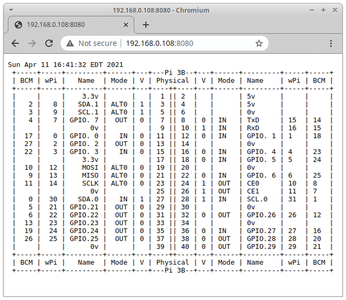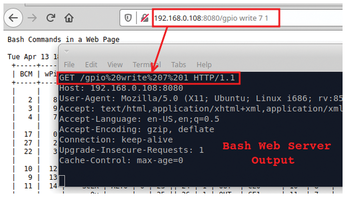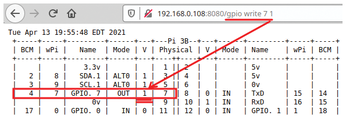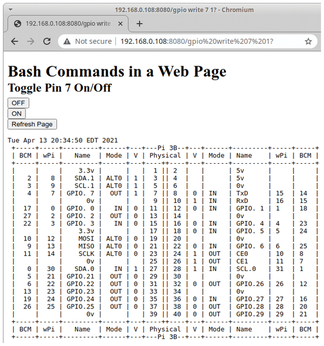A Bash web server
Bash Web Server with Raspberry Pi GPIO
For many Raspberry Pi projects, monitoring the status of the General Purpose Input/Output (GPIO) pins is quite important.
The Raspberry Pi gpio utility is a command-line tool that can be used to read and write to GPIO pins. The readall option can be used to show the present status of all the GPIO pins.
Rather than passing the Bash commands as a string, an alternative approach is to use a Bash script and then call (sh) that file. An example script file (web_body.sh) that shows the time and then calls the gpio readall command would be:
#!/bin/bash # web_body.sh - Show the time and # PI GPIO pins date $T echo "$(gpio readall)"
To run this script file in a Bash web server, use the following command:
while true; do { \
echo -ne "HTTP/1.1 200 OK\r\n"; \
sh web_body.sh; } \
| nc -l -k -q 2 8080; \
doneFigure 3 shows the web page with the GPIO pins' time and the status.

Send GPIO Writes from the Address Bar
Client-side GET requests can be simulated on the browser address bar. For example, entering
gpio write 7 1
in the address bar sends that string to the Bash Server as a GET request.
In Figure 4, you can see that the HTTP request uses HTML encoding. In this example, a space is converted to %20.

Bash code can be added to look for specific messages. In this case, you can search for the "gpio write 7 1" or "gpio write 7 0" messages. If found, the code then executes the extracted message.
The Bash web server code now is modified to look for the "GET gpio" message and then decode any HTTP %20 characters to spaces. Next, the code parses out the string to get the GPIO message and finally executes the required command:
while true;
do { echo -ne "HTTP/1.1 200 OK\r\n"; \
sh web_body.sh; } | \
nc -l -k -q 5 8080 | \
grep "GET /gpio" | \
sed -e 's/%20/ /g' | \
eval $( awk '{print substr($0,6,15) }') ;
doneWith the new code, the "gpio write" text entered in the address bar is executed, and the result can be seen in the web page (Figure 5).

Create an HTML Form
Entering commands on the command line works, but it's crude. A better way is to create an HTML Form.
The Bash web server code can remain exactly the same as in the earlier example. The original script (web_body.sh) file can be modified to output in HTML format, and three forms can be included (Listing 2). The first and second forms will define the GET actions to turn the GPIO pin on or off, and the third form will be used to refresh the page to check for GPIO changes. Figure 6 shows the client web page with buttons to turn on and off a GPIO pin. After toggling the GPIO pin, a refresh of the web page is required to see the new status.
Listing 2
Toggling a Rasp Pi GPIO Pin
#!/bin/bash # web_body.sh - Show the time and PI GPIO pins # - Use HTML instead of text output # - Add forms for GPIO on/off, and a refresh echo " <!DOCTYPE html><html><head> </head><body> <h1>Bash Commands in a Web Page</h1> <h2>Toggle Pin 7 On/Off</h2> <form action='gpio write 7 0'> <input type='submit' value='OFF'> </form> <form action='gpio write 7 1'> <input type='submit' value='ON'> </form> <form action=''> <input type='submit' value='Refresh Page'> </form> <pre> " date $T echo "$(gpio readall)" echo "</pre></body></html>"

The nc utility is extremely powerful, but it can be rather dangerous in that it can create back doors into your system. In this example, the code was specifically looking for the string "GET /gpio". This allows only gpio commands to be passed. However, if the code only looked for "GET /", then you could potentially pass any command string to your server.
« Previous 1 2 3 Next »
Buy this article as PDF
(incl. VAT)
Buy Linux Magazine
Subscribe to our Linux Newsletters
Find Linux and Open Source Jobs
Subscribe to our ADMIN Newsletters
Support Our Work
Linux Magazine content is made possible with support from readers like you. Please consider contributing when you’ve found an article to be beneficial.

News
-
TUXEDO Computers Unveils Linux Laptop Featuring AMD Ryzen CPU
This latest release is the first laptop to include the new CPU from Ryzen and Linux preinstalled.
-
XZ Gets the All-Clear
The back door xz vulnerability has been officially reverted for Fedora 40 and versions 38 and 39 were never affected.
-
Canonical Collaborates with Qualcomm on New Venture
This new joint effort is geared toward bringing Ubuntu and Ubuntu Core to Qualcomm-powered devices.
-
Kodi 21.0 Open-Source Entertainment Hub Released
After a year of development, the award-winning Kodi cross-platform, media center software is now available with many new additions and improvements.
-
Linux Usage Increases in Two Key Areas
If market share is your thing, you'll be happy to know that Linux is on the rise in two areas that, if they keep climbing, could have serious meaning for Linux's future.
-
Vulnerability Discovered in xz Libraries
An urgent alert for Fedora 40 has been posted and users should pay attention.
-
Canonical Bumps LTS Support to 12 years
If you're worried that your Ubuntu LTS release won't be supported long enough to last, Canonical has a surprise for you in the form of 12 years of security coverage.
-
Fedora 40 Beta Released Soon
With the official release of Fedora 40 coming in April, it's almost time to download the beta and see what's new.
-
New Pentesting Distribution to Compete with Kali Linux
SnoopGod is now available for your testing needs
-
Juno Computers Launches Another Linux Laptop
If you're looking for a powerhouse laptop that runs Ubuntu, the Juno Computers Neptune 17 v6 should be on your radar.

